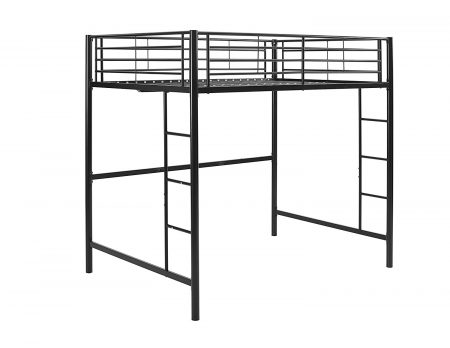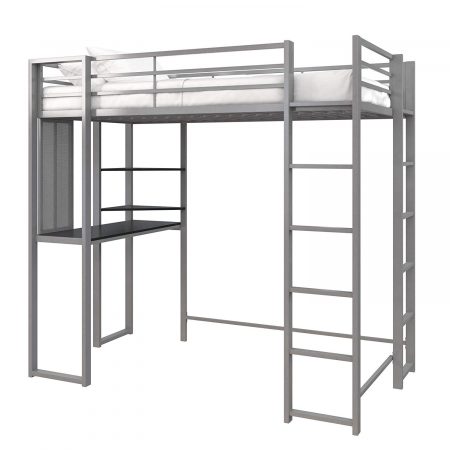Common Materials, Characteristics, and Prices
Next, we’ll look at materials used to construct loft beds, common safety features, and other important characteristics.
Materials
The vast majority of loft beds are made from wood, metal, or a combination of both. Wood materials may include maple, oak, cherry, walnut, rubberwood, pine, or composite wood – a material manufactured by bonding wood fiber to produce a steadier product.
Metal loft beds, on the other hand, may be built from steel tubes, metal rods, or wrought iron. Steel tubes are among the most popular materials in bunk beds because of their light weight and sturdy construction. Metal materials are often coated with a powder-coat finish that is tougher than traditional paint and thus better able to resist scratching, chipping, and rust.
Safety Features
Guardrails are among the most important safety feature for loft beds. While adult beds are not required to have guardrails, loft bed for children should feature guardrails on both sides. For adults and children, ladders should be firmly attached to the upper bunk. Consider adding a nightlight to illuminate the ladder and make it easy to locate in the dark when attempting to exit the bed.
Style and Size
Loft beds are available in a huge variety of styles, from sleek, contemporary metal to rustic wood. There are also novelty bunk beds complete with treehouses, playhouses, and swings, in addition to creative l-shaped frames that allow for even more storage beneath.
Price Ranges
Depending on the size, material, and special features, loft beds may come in a vast variety of price ranges. Here are some average prices you can expect while shopping for loft beds:
- Children’s metal bed: $150 – $200
- Children’s wood bed: $300 – $500
- Twin adult metal bed: $170 – $250
- Twin adult wood bed: $300 – $600
- Full adult wood bed: $400 – $800
Loft beds typically come in twin sizes for children and full sizes for adults. However, both queen-size and custom-size beds may be available. Many loft beds are backed by a wide range of warranties, from 30-days to a year.
Other Space-Saving Bed Types
Loft beds aren’t the only way a bed can save living space. We’ve listed some common types of space-saving beds below.
Bunk Beds: Popular among children’s and guest rooms as well as dorm rooms and hostels, bunk beds feature two beds — typically twin-size — stacked on top of each other to accommodate two sleepers.
Trundle Beds: Trundle beds also feature two beds in one unit, stacked on top of each other. These beds are typically twin-size or full-size. The top bed is typically standard bed height with the additional frame located directly underneath. The lower bed often features a thinner mattress and can be rolled out from underneath the upper bed with ropes or handles.
Murphy Beds: A creative way to use wall space, murphy beds — sometimes called a “pull-down bed” — are hinged at the top so they may be folded up and stored vertically inside a wall or cabinet.
Sleeper Sofa: Also called “sofa beds”, sleeper sofas are couches with seating cushions that conceal a pull-out bed underneath. The mattress is typically thin and sits on a metal frame that unfolds to create a bed.



